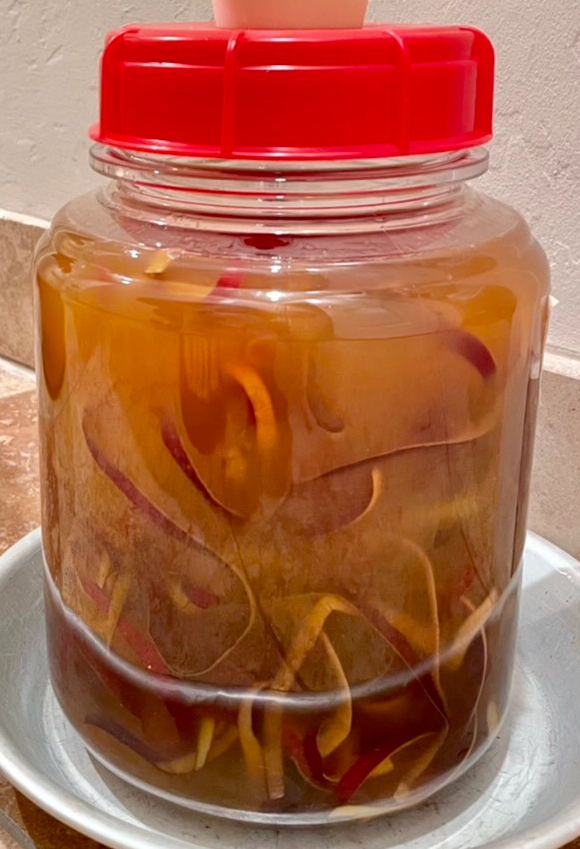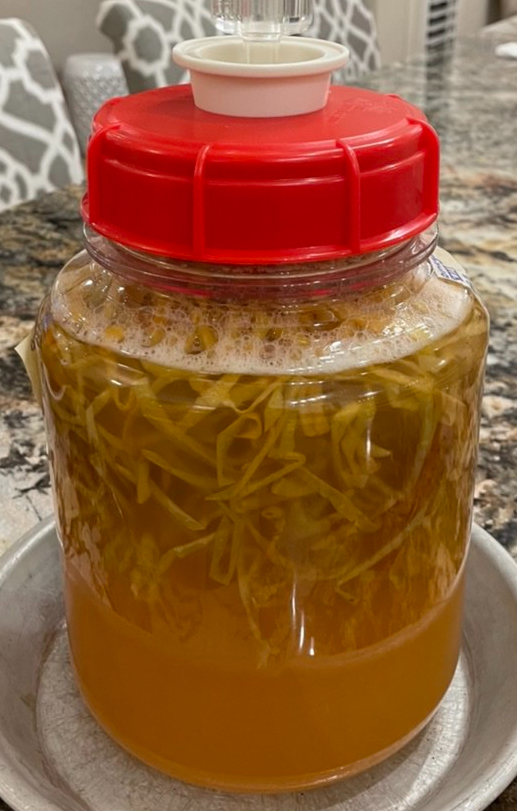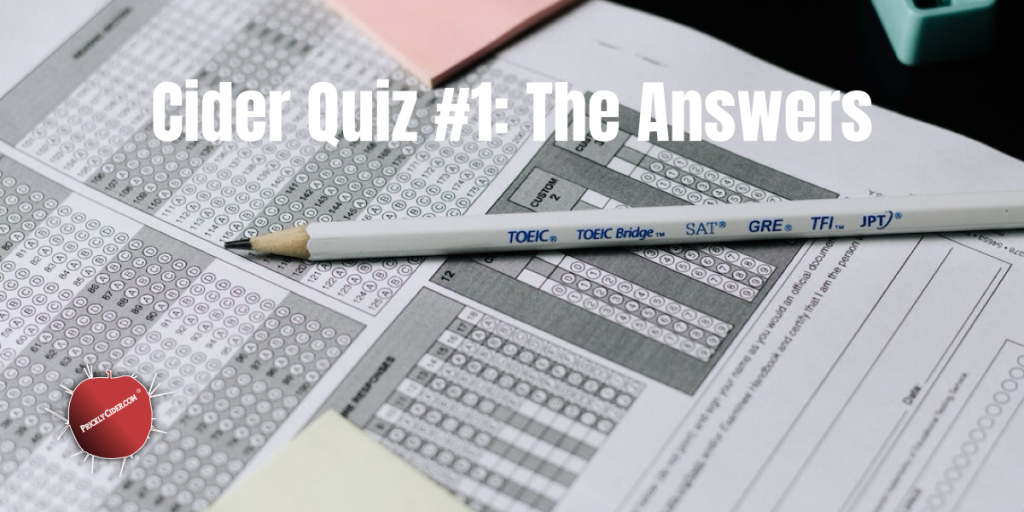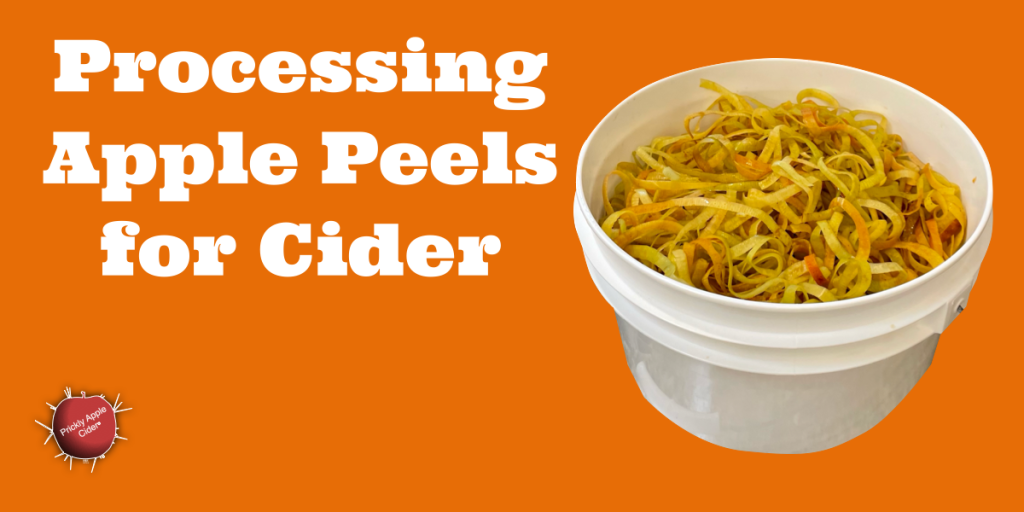I’ve talked about the color of hard cider and how the process for making wine can be used as a reference. This is because like wine, cider color can be influenced by the fruit as well as the process. In another post on hard cider color, I explored how to make what I call silver cider. Silver cider is analogous to white wine. The goal is a very clear or silvery looking hard cider with minimal hues. That means that the cider most likely has little polyphenols or tannins. Tannins are what give color to cider and not just brown or amber. Just like with wine, you can make a red hard cider. You can also make an orange or rose cider. I’m been working on a yellow hard cider but my results are definitely more orange at this point. The really cool thing is that all of this is done without adjuncts. It’s all apple and it not red fleshed apples, though red fleshed apples are very cool. Here are some examples to get you interested.

In the above photo, the hard cider on the left is 100% Arkansas Black and the one on the right is 100% GoldRush apples. If you have explored the recipe for my Black Magic cider or read my post about the missing ingredient of cider, you know I advocate the use of apple peels in the fermenting process for hard cider. This is because the peels and the core/seeds have the largest concentration of polyphenols in the apple. Even apples that have minimal tannins in their flesh will have tannins in their peels. Adding the peels to the fermenter will enable enzymatic breakdown to occur transferring these polyphenols to your cider. That includes polyphenols that are visual, which creates colors. This is the same process used by wine makers for thousands of years to create red and rose wines. It is also similar to how some traditional hard ciders use extended maceration for tannins and color transfer.
Grapes are much easier to crush and extract juice for fermentation. Fermenting on the apple peel requires more intervention. But that intervention isn’t really excessive. You can get industrial peelers or as my wife and I do, it just becomes an additional step in your pressing process. I peel with an hand-turned peeler (check out the model on the product recommendation page) before giving her the peeled apple to run through the mill or masticating juicer in my case. This isn’t a question of effort, we all go through extreme amounts of effort to create our craft hard ciders. This is about results. Besides the addition of tannins, especially those producing astringency versus bitterness, it also adds aromas. However, this post is about exploring the color of hard cider. It’s all about the visual aspects of cider. Have you ever seen a red hard cider that was made from 100% apples? How many orange hard ciders have you made? I think my orange and red ciders look visually appealing even before I sample them.
I’ve provided guidance on how to harvest and use apple peels in the above mentioned posts so I am focusing his discussion on color. I have pursued four basic colors so far: Amber, Red, Yellow, and Orange. I will share my thoughts on what I’ve learned about these before covering a final visual element, clarity.
Amber
My initial foray into color augmentation of hard cider was to create that dark amber color I always considered to be the gold standard of cider. My color palette has broadened but my initial quest was to recreate this deep amber hue. While I was successful with adjuncts, I wanted a way to create it from apples. A little Arkansas Black apple peel placed in my fermenter resulted in my first success and Black Magic cider was born. However, I didn’t just use these peels with Arkansas Black apple juice. I also included them in other juice. My Pippin Magic was a successful example of this type of venture. I added Arkansas Black peels to a juice made from Newtown Pippin apples. The results was a nice amber hue to my hard cider. That got me trying other apple peels. What I found was that including about 4 pounds (1.8kg) per gallon (3.8 liters) of a solid red apple would give me a nice dark amber color. If you can’t get Arkansas Black apples, try using Black Oxford, Red Delicious, Chieftain, or apples with a similar solid deep red color. I make no claims as to the impact different peels will have on polyphenols and aroma other than they will go up. Like using different apples, different peels added to your blend will have different impacts. However, you can achieve a nice amber color by adding a small to medium amount of red peels and it will also increase your phenolic compounds and aroma.
Method: Peels from 4 lbs (1.8kg) apples / gallon (3.8L) juice
Red
Once I had positive results making amber colored hard cider, I started thinking about how far I could push the colors. My next plan was to bump up the amount of peels I included. My first attempt was about double the level of peels (~8 pounds/3.6kg of apples per gallon) as I was using. This is where I noticed more red tones versus amber. That led me to go even bigger. For this year’s Black Magic cider, I added all the peels from every apple, about 16 pounds (7.3kg) worth of apples. Yes, I need to start weighing my actual peels but this is an evolving experiment. The above slideshow documents the results: pre-fermentation juice and peels, post-fermentation hard cider and peels, and bottled cider. That’s red hard cider! It’s also fruity, aromatic, astringent, and quite good. It’s also an amazing color.
Method: Peels from 12-16 lbs (5.5-7.2kg) apples / gallon (3.8L) juice
Orange
I must admit, I was really trying for yellow hard cider. I tried my normal amount of peels (from about 25% of the apples I pressed) in the primary with Ambrosia apple peels. Ambrosia is a modern seedling that I consider a great aroma apple. It has a thin yellow slick peel with some red sun spots. The result was an orange hue. I decided to go big on another batch and loaded the fermenter with all the peels of the GoldRush apples I pressed. GoldRush is another modern yellow apple but the skin is slightly thicker and coarser. It has good acid, some tannins, and strong sugar. The above slideshow steps you through the pre-ferment, post-ferment, and bottled cider. It’s also the bottle on the right in the first picture. Again, I was trying for yellow. I got a very robust orange. I also got orange when I mixed red and yellow apple peels in equal quantities. I tried this on other batches. It seems orange is a more readily achievable hue with peels than red and definitely more than yellow.
Method: Peels from 4-16 lbs (1.8-7.3kg) apples / gallon (3.8L) juice
Yellow
The above is my Super Yellow rootstock apple pre and post pectic clarification. This one is still aging and I didn’t add any peels to it. It naturally has a yellow hue even though the apple peel has a yellow base with red streaks. I have yet to find a way to create a strong yellow color as most tend to veer orange. I believe this is the oxidation of tannins combining with the yellow pigments to create a nice robust orange. I will continue to explore this to see if I can find a way to create yellow hard cider and you can expect another article if I do. I am also experimenting with secondary fermentation and aging using peels. I have an ice cider that has peels from about 4 pounds of Arkansas Black apples added to it after primary fermentation completed. I’m wondering how the color, aromas, and tannins will differ in a secondary process. The color experiments are continuing. However, I have noticed one potential concern and that is clarity.
Method: To be Defined
Clear versus Cloudy
Apple peels contain a massive amount of polyphenols. My theory is that this creates more opportunities for protein-polyphenol bonds with low molecular weight polyphenols. This can result in protein haze or chill haze. While some of my hard ciders are very clear, I have noticed others made with peels have a slight haze. As shown above, the three bottles look to have similar clarity but the middle one is more obscured. Check out the second and third photo and you will see what I mean. Like most ciders, time seems to precipitate out this haze but not always or at least not always quickly. It’s one of the interesting learnings I’ve had from my peel experiments. You will get more bitter and astringent hard ciders but you might also find they can have a slight haze to them as well. You can cold crash but it might take fining, filtering, or age to clarify completely. I must say that most of mine do clarify with time and bottling usually helps them clear quicker but can leave some residue in the bottom of the bottles.
Hopefully, this has given you some ideas on how you can create wonderfully colored hard ciders by using peels. Not only do peels add phenolic and aromatic complexity, they also create 100% naturally colored ciders. It’s another example how the apple peel truly is the missing ingredient for colorful and tasty hard ciders.
Did you enjoy this article? Don’t miss future posts from PricklyCider.com by following us today! PricklyCider.com is your source for all things cider.



















